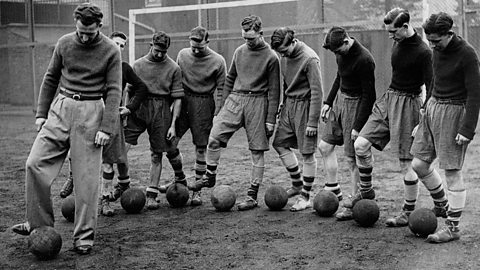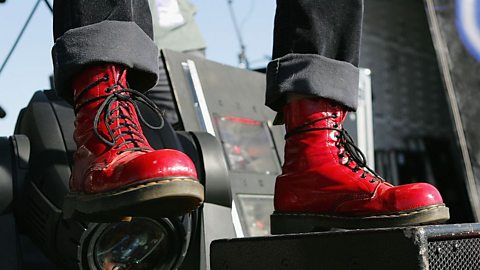A ban on any item tends to bring it into the headlines.
Over the years, there have been well-known cases of banned books, films and records which have, perhaps, made the public more keen to learn about them.
But there have been occasions when things have been banned which, when looked at from a modern perspective, seem baffling. No football in England or Scotland? Popcorn barred from cinemas? A no to women wearing trousers in a fashion capital? ┤¾¤¾┤½├¢ Bitesize has taken a delve into the world of everyday items which once had people reaching for the prohibited sign.
No opera, no ballet, no recorded music
It decides who lives to slay another day on RuPaulÔÇÖs Drag Race and is the main ingredient in many a TikTok post. But could you image a world without lip syncing?

ThatÔÇÖs exactly what happened in 2005, in Turkmenistan in Central Asia. The countryÔÇÖs then president, Saparmurat Niyazov, was reported to have been so upset at seeing some of the countryÔÇÖs biggest and more established stars miming on TV shows to their biggest hits, he decided it was doing his countryÔÇÖs proud cultural heritage irreparable harm. His reaction was to ban recorded music on TV, in public performances and, interestingly, at weddings. If you couldnÔÇÖt sing live, youÔÇÖd soon be found out.
This wasnÔÇÖt an unprecedented move for President Niyazov, however. He banned opera and ballet in 2001 as he didnÔÇÖt consider them to be art forms in line with the national spirit.
Niyazov passed away in 2006. His successor, Gurbanguly Berdymukhamedov, lifted the restrictions on many of the things his predecessor had banned. Opera returned to Turkmenistan in 2019.
The European chintz smugglers
You may have heard the phrase ÔÇÿchintzyÔÇÖ applied to home furnishings where there are lots of frills and florals going on. But chintz itself is a fabric which first appeared in India and Pakistan thousands of years ago. It was so sought after in Europe, its popularity led to it being banned.
Chintz is a type of cotton which has substances called mordants (or resists) applied to it. These substances help dyes stick to the fabric, even after washing, so chintz became associated with bright colours and floral designs. The diarist Samuel Pepys even bought chintz wallpaper for his wifeÔÇÖs study.

The fabric became such a status symbol that cotton merchants based outside India and Pakistan - particularly in Europe - who made their living importing chintz enjoyed a decent lifestyle. There was a more sinister side, however - the valuable fabric was also used in part-trade for enslaved people along the African sailing routes.
In Europe's domestic cotton and fabric markets, the negative financial impact of chintz's popularity was becoming a problem. It became such an issue that drastic measures were sought, namely a ban on the fabric being imported. Such bans were in place in France from 1686 to 1759 and there was a partial ban in Britain from 1700 to 1774. Other countries also brought in precautions linked to importing chintz and other desirable fabrics from the Asian market. Some traders were threatened with execution if they brought chintz into the country, but the fabric was so popular, it continued to be smuggled across borders, and openly worn, during the respective bans.
When silent cinema refused to pop
Popcorn is cheap and easy to make. A night at the cinema is a fun way to enjoy a few hours while tucking in to a few snacks. The two have gone hand in hand for decades.

That wasnÔÇÖt always the case. When cinemas first opened in the United States in the early 1900s, before film had sound, they werenÔÇÖt aimed at the general population. The people who ran cinemas wanted to attract a wealthy clientele and make an evening of watching moving pictures on a screen, as sophisticated as attending a night at the theatre. That meant there were furnishings to match, with the finest upholstery and carpets.
By this point, popcorn was widely available from vendors in the street, so cinema owners banned it from being brought on to their plush premises.
It was the Great Depression in the late 1920s and early 1930s which finally brought food and film together. Watching a movie was an affordable means of escaping the problems outside for a couple of hours, and popcorn was still a snack within peopleÔÇÖs budgets. As more people of lower social class came into cinemas, owners were more relaxed about them bringing popcorn in with them.
The vendors, spotting an opportunity, moved their stalls closer to the movie house doors. They were eventually charged for the privilege by the cinema owners. Later, popcorn was sold on the cinema premises itself as the boost to profits from selling it in-house became apparent.
Hiding the beautiful game away
In a country that is passionate about the game, it may be surprising that football has been banned on occasion in England and Scotland.
It does involve a long scroll back through the centuries to find this particular brand of sporting prohibition, but it took place in the 14th and 15th Centuries.
King Edward II of England could not stand the noise created when people played the beautiful game. It was even proclaimed: ÔÇ£For as much as there is great noise in the city, caused by hustling over large balls from which many evils might arise which God forbid, we command and forbid, on behalf of the king, a pain of imprisonment, such game to be used in the city in the future.ÔÇØ
This may seem a strange way to describe a kickabout between friends. Back then, football was very different and involved large groups of people in each team (much bigger than todayÔÇÖs squads) playing across a wider area, meaning more noise and potentially more disruption to those around them.
It was 13 April 1314 when Edward II imposed his ban, although it only extended to London.
His successor, Edward III, went a step further. In 1365, he issued a decree banning football across all England, as well as handball and ÔÇ£vain games of no valueÔÇØ.
In Scotland in 1424, King James I approved a ban of football. The game was so popular, it was thought to be a distraction from military training, when young men should be concentrating on their archery instead. Anyone caught playing football faced a fine of fourpence.

No ├®galit├® for the women of Paris
Paris is one of the worldÔÇÖs fashion capitals, renowned for its chic and pioneering approach to design.
But up until the early 2010s it was, theoretically, illegal for women to wear trousers in the French capital.
This intriguing law dates back to 1800 when the cityÔÇÖs police chief decided his office needed to give clearance to any woman wishing to wear menÔÇÖs clothing. This was in place for 92 years, before it was decided women could wear trousers in Paris while on horseback, provided they held on to the reins at all times.
Another reform appeared in 1909, to allow trousers for women riding bicycles - but they had to have both hands on the handlebars, even while walking on the pavement and pushing their bike along. As fashions and public views changed, there were attempts to repeal the law in 1969 and 2003, but both were unsuccessful. By this stage, the ban was ignored despite remaining on the statute books. The cityÔÇÖs female police officers were also wearing trousers.
It was 2013 when the ban was finally lifted and equality on clothing choice was legal in Paris once more.

Quiz: Why were these books banned?
Will your favourite book be mentioned?

From Dixie Dean to Raheem Sterling: How have the stars of men's football changed?
From wages to fitness and a bit of Instagram, we take a look at the rise of the football superstar in England.

Histories of the mini skirt, the white wedding dress, and why the tale you've probably heard about nylon isn't true.
